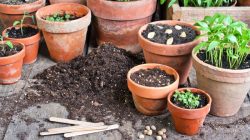Growth Habits and Characteristics

Male vs female pot plant – Male and female cannabis plants, while genetically similar, exhibit distinct growth patterns and physical characteristics. These differences are crucial for cultivators aiming to maximize yields, as female plants are the sole producers of the sought-after buds containing cannabinoids like THC and CBD. Understanding these distinctions is essential for successful cultivation. This section will detail the observable differences in growth habits, physical attributes, and root systems between male and female cannabis plants, using examples to illustrate these variations.
Growth Patterns and Physical Differences
Male and female cannabis plants display contrasting growth habits. Generally, male plants tend to grow taller and more lanky, focusing energy on developing pollen sacs. Female plants, conversely, are often bushier and more compact, allocating resources towards bud production. These differences are not absolute; environmental factors and genetics play a role. However, these general trends are widely observed across various cannabis strains.
For example, a male
- Cannabis sativa* plant might exhibit a tall, slender structure with long internodal spacing, while a female plant of the same species might be shorter and broader, with more densely packed branches and leaves. Similarly, a male
- Cannabis indica* plant may display a more compact structure than its
- sativa* counterpart, but it will still generally be taller and less bushy than the corresponding female plant.
Observable Physical Differences in Cannabis Plants
The following table summarizes the key physical differences between male and female cannabis plants of the same species:
| Plant Species | Male Characteristics | Female Characteristics |
|---|---|---|
| Cannabis sativa | Tall and lanky, long internodal spacing, fewer leaves, development of pollen sacs at nodes. | Shorter and bushier, shorter internodal spacing, more leaves, development of buds (calyxes) at nodes. |
| Cannabis indica | Relatively shorter than sativa males, but still taller and lankier than females, pollen sacs develop at nodes. | Compact and bushy, abundant leaves, development of resinous buds (calyxes) at nodes. |
| Cannabis ruderalis | Smaller than both sativa and indica males, less pronounced differences compared to females. | Smaller than sativa and indica females, often autoflowering, develops buds at nodes. |
Root System Differences
While less visually apparent than above-ground differences, male and female cannabis plants also exhibit variations in their root systems. Generally, male plants tend to develop a more taproot-dominant system, extending a single, strong root deep into the soil. This is likely an adaptation to compete for resources in a crowded environment. Female plants, in contrast, often develop a more fibrous root system with numerous lateral roots spreading horizontally near the soil surface.
This allows for efficient absorption of nutrients and water, supporting the energy-intensive process of bud production. The differences in root structure are not always dramatic and are influenced by growing conditions. For instance, a
- Cannabis sativa* grown in a pot with limited space may show a more compact root system than one grown in open ground, regardless of sex. Conversely, a
- Cannabis indica* plant grown in well-drained soil might exhibit a more extensive lateral root system than one grown in compacted soil. These variations highlight the interplay between genetics and environmental factors in shaping root development.
Flowering and Reproduction: Male Vs Female Pot Plant

The reproductive process in dioecious plants, like many cannabis varieties, involves distinct male and female individuals. Understanding the differences in their flowering patterns and reproductive structures is crucial for cultivation and breeding purposes. The timing, duration, and morphology of flowering significantly impact seed production and the overall yield of desired plant components.
The timing and duration of flowering in male and female cannabis plants are influenced by several factors, including genetics, photoperiod (day length), and environmental conditions. Generally, flowering begins when the plants reach a certain maturity level and experience a change in the photoperiod. Once flowering is triggered, the differences between male and female plants become strikingly apparent.
Flowering Time and Duration
The flowering period for both male and female plants typically begins after the vegetative growth phase. However, the duration varies considerably depending on the specific strain and environmental conditions. Male plants generally flower earlier than females, focusing their energy on pollen production. Once flowering begins, the male plants will usually complete their reproductive cycle within a shorter timeframe compared to females.
- Male Cannabis Plants: Flowering typically begins after 6-8 weeks of vegetative growth under a 12/12 light cycle, lasting for another 2-4 weeks. Pollen production then ceases, and the plant dies.
- Female Cannabis Plants: Flowering begins similarly under a 12/12 light cycle but can extend for 6-12 weeks or more, depending on the strain. This extended period allows for the development of buds containing the seeds.
Morphological Differences in Male and Female Flowers, Male vs female pot plant
Male and female cannabis flowers exhibit significant morphological differences. These differences are crucial for distinguishing sexes during the early stages of flowering and for selective breeding practices.
Male Flowers: Male flowers are typically smaller and less conspicuous than female flowers. They appear as clusters of small, pollen-producing sacs called stamens. These sacs are usually light green or yellow, hanging in loose clusters, often described as “bananas” due to their shape. The stamens are comprised of filaments which bear anthers, containing the pollen. The shape is generally elongated and teardrop-like.
Female Flowers: Female flowers are characterized by the presence of pistils, which consist of a stigma (the receptive part of the flower) and an ovary (containing the ovules). These pistils are easily identifiable by their two long, slender, white hairs (stigmas) emerging from a small, calyx-like structure (bract). These stigmas collect pollen. The bracts swell as the ovules develop, eventually forming the buds that are harvested for various purposes.
The shape is generally more compact and rounded compared to the male flowers.
Pollination Process
Pollination in cannabis plants involves the transfer of pollen from the anthers of male flowers to the stigmas of female flowers. This process can occur through various mechanisms, including wind pollination (anemophily) and insect pollination (entomophily), although wind is the primary method for cannabis.
Wind Pollination: The lightweight pollen grains are easily dispersed by the wind, carrying them from male to female plants. This method is less efficient than insect pollination but is effective over larger distances. Cannabis relies primarily on this method.
Self-Pollination: While cannabis is dioecious (separate sexes), some degree of self-pollination can occur under certain circumstances, especially in monoecious plants which have both male and female flowers on the same plant. However, this is less common and generally less desirable in controlled cultivation.
Example: Cannabis sativa (marijuana) primarily relies on wind pollination for reproduction. The pollen released from male plants is carried by wind currents to the female plants, where it fertilizes the ovules, leading to seed production. However, growers often separate male and female plants to prevent unwanted seed production and to maximize the development of resinous buds in female plants.
User Queries
Can I tell the sex of a pot plant from a seed?
Nope, you can’t. Seedlings don’t show their sex until they start to mature.
Do male pot plants have any value?
Yes! While females produce the buds, males are crucial for pollination (if you’re breeding) and can have other uses depending on the species.
What happens if I don’t remove male plants?
If you’re growing for buds (like cannabis), male plants will pollinate the females, resulting in seed production and reduced potency of the buds.
Are all plants dioecious (having separate sexes)?
No, many plants are monoecious, meaning they have both male and female flowers on the same plant.
Can I propagate a plant from just a leaf?
It depends on the species! Some plants can be propagated from cuttings, others require seeds or other methods.










